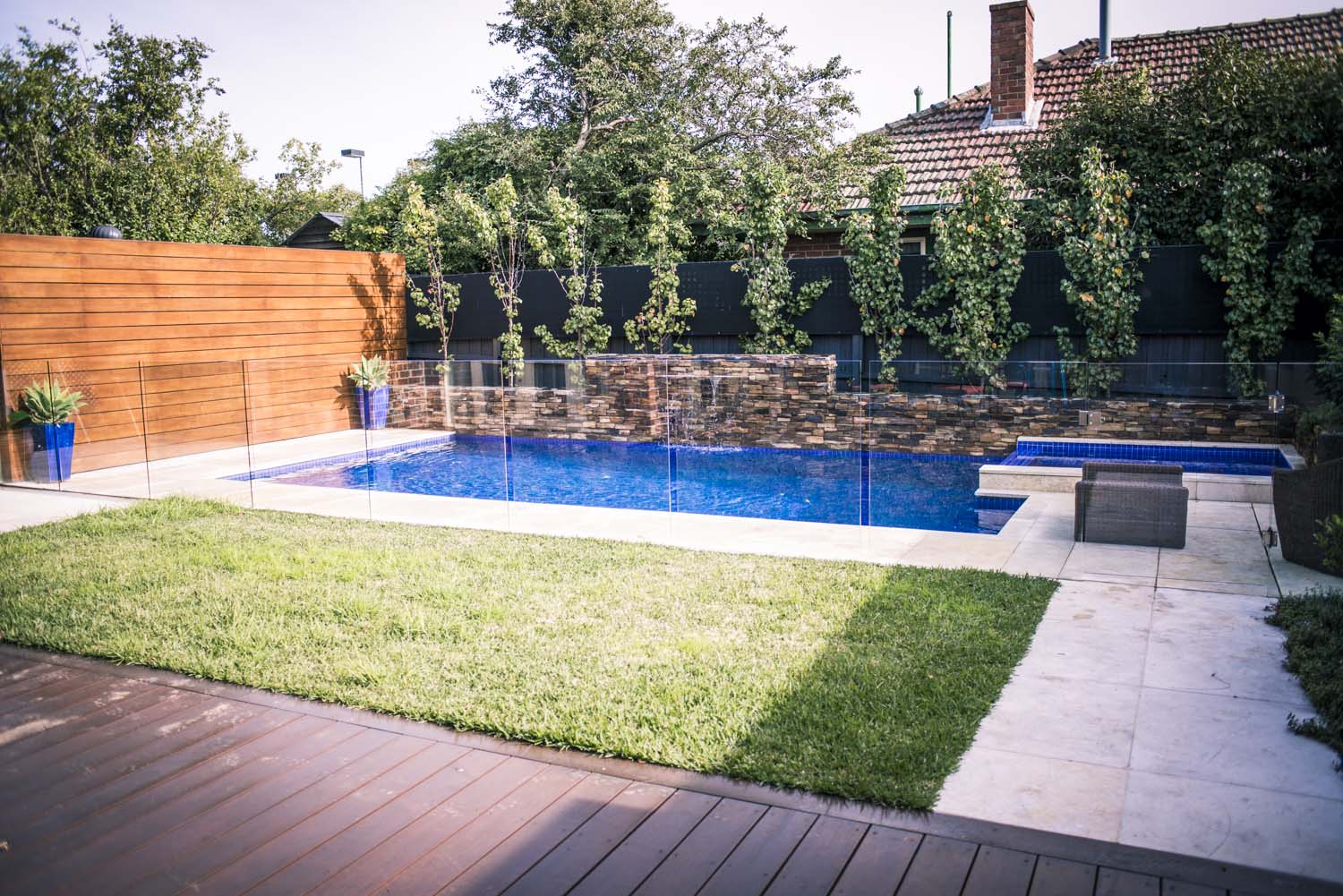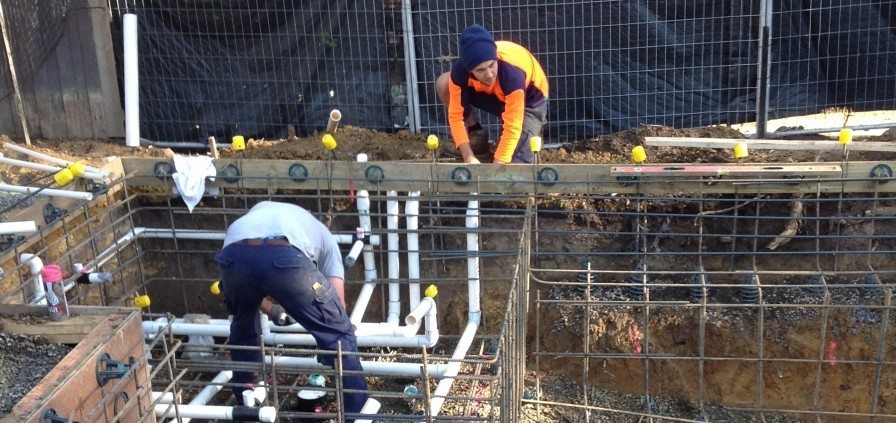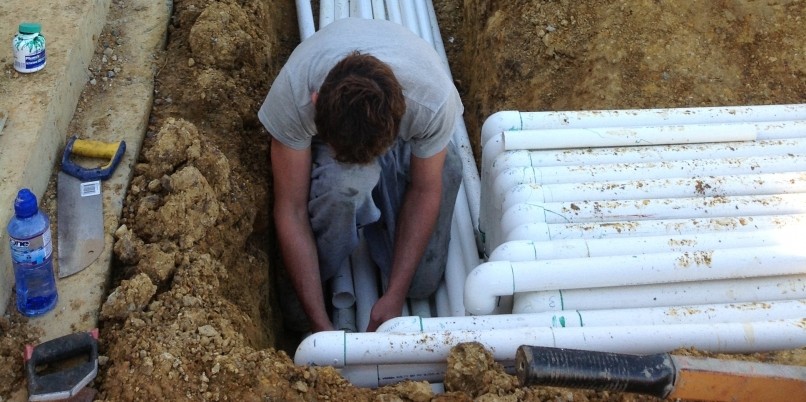In this guide, we will discuss every topic there is to buying, owning and maintaining a swimming pool. This is the ultimate Pool Buyer’s Bible.

Why Would I Build a Pool?
There are three main reasons that people build pools: Family, show-piece and health.
For young families, a pool in the backyard is the perfect answer to hot Aussie Summers. Kids love nothing more than jumping into their very own pools to splash around and cool off.
If you are someone with a luxurious modern home, then a well designed pool can be the perfect focal point to highlight your tastes and sense of design.
Lastly, swimming is known to be extremely good for overall health. Take a look at this Time article which outlines some benefits you can enjoy in your new pool.
How Much Will My New Pool Cost?
A well finished entry level concrete in-ground pool will start from around $40,000 for a 6m x 3m fully customisable pool. The price will vary depending on what finishes and tiles you choose.
While $40k is no small amount of money, there is nothing cheap about what is offered for this price. All pools are built with premium materials, and full of quality features.
As a standard, Momentum Pools includes a 3D pool design and site layout, solar heating, variable speed pumps, LED pool lights (2 minimum), all excavation costs, auto testing and dosing chlorinators, 300mm waterline tiles and step edge tiles.
In-ground concrete swimming pools are at the premium end of the pool market, so while an entry level pool will cost upward of $40k, a much larger and more complex pool can go well into the hundreds of thousands of dollars. Some of these additions include fencing and landscaping which can mean an additional 25% – 100% of the cost of the base pool. This makes a $40k pool at least $50k quite quickly.

The average price of a pool built by Momentum Pools is approximately $75,000.
Typically, 35% of the price of the pool goes to services, pool fencing and landscaping, which results in a total spend of around $100,000.
Take a look at our full breakdown of a realistic pool project budget.
If you have a specific design in mind, try our Pool Prices Calculator to get a rough, but accurate cost estimation.
Now that I’ve invested in a new pool, will it add value to my existing home?
This can be a complex question to answer and is open to speculation. In our experience, we have observed certain trends within the property marketplace.
- Homes being sold often feature pool photos front and centre as a selling point.
- Display homes nearly always have pools that are disproportionately valued against the homes they are built alongside to up-sell and add prestige.
While it is difficult to give a definitive answer, the fact of the matter is that pools can indeed add value to homes, and are used frequently as a home selling strategy. It greatly depends on the market at the time and if potential buyers want the kind of lifestyle that comes with owning a pool, as it does come with its own upkeep and maintenance.

So, what does it cost to upkeep and maintain your new pool?
There are a few factors that contribute to this. Electricity costs for heated pools, consumables and various chemicals and maintenance for significant pieces of pool machinery. We have a full breakdown for estimated costs that will give you an idea of how much you may be paying per year. We also have a Pool Chemical Costs calculator to determine what your specific sized pool may cost.
You must also take into consideration the cost of filling a pool. This can vary greatly based on location and the size of your pool. But yes, as you guessed we also have a Pool Filling Cost Calculator.
Designing Your Pool
Before you have your pool built, you should sit down and consider exactly what kind of pool you want, as well as any features you might want to add.
We have a very comprehensive page covering a number of tips for planning your pool. Take a read through there and carefully consider the options before you.

The customer came up with the idea to add a Acylic viewing panel on his existing pool – to this he advised his architect who renovated the home with acrylic viewing window as the showpiece.
Should I go with a fibreglass pool or an in-ground concrete pool?
Many people do not know or understand the difference between concrete and fibreglass pools. There are many important distinctions between the two. Concrete has always been a premium pool construction material due to it’s longevity and customisation nature. Fibreglass pools are pre-made and not customisable. Their main benefit is being a low cost option.
Overall, concrete is considered the superior option for the following reasons:
- Fully customisable
- Structurally sound
- Limitless sizes and configurations
- Concrete is classy when compared to fibreglass
- Local governments specify concrete as the construction material of choice for any new pool construction.
There are many issues with fibreglass pools such as voids forming around the pool walls and shape deformation resulting in structural failure. Otherwise, it generally feels and looks cheap!
Should I add a spa?
As per our page on design considerations, you should have an understanding of what your pool will be used for, and what fits your budget.
Adding a spa can greatly increase the construction costs of your pool. If you want a pool for exercise or family fun, then it may not be necessary. However if you are the kind of people who entertain and host parties, then you can benefit greatly from a spa. Ultimately, it is just a matter of money, and if you have it spare, then why not?

I have a small property… how much room do I need for a pool?
A well designed pool should be a complimentary additionin to your outdoor living area. The pool’s design should include allocated space and position according to how the remaining outdoor space will be used year round.
Grassy areas for children and animals should be available for year round entertainment. Keep in mind the potential for al fresco entertainment areas to protect from the sun in summer and keep you warm during winter. Swimming pools are not the be all and end all of outdoor design, but should be considered as additions to an outdoor space.
With that being said, there are a few basic rules that we follow when considering a pool design:
- Build your pool and surround to occupy ~25% of the available area.
- Ensure the pool surrounds occupy an area of ~50% of the pool surface area.
- A pool always looks good, but a well designed pool looks great.

Should I fully tile my pool?
A fully tiled pool is more durable, smoother, less chemically reactive and colourfast. Nearly every commercial pool in Australia is fully tiled. They are a quality option, but they do come at a price. If your budget does not cover them, we also fit waterline tiles and fine pebble interiors where required. But the quality, durability and look of tiles is well worth it.
Momentum Pools uses only the best available tiles. Take a look at what we currently have on offer.
How deep should my pool be?
Setting water depths in a pool can be very tricky. Diving into shallow water is a massive risk and a common injury, so striking the balance is not always easy. Check out our comprehensive guide on pool depth.
The Building Process
The start of the building process is always choosing a pool builder. There are some key steps you can follow to make the best choice for your needs.
- Obtain references – They should be easy to obtain from any reputable builder. Request the details of people who have had similar contracted work done, and arrange to visit them to view the finished product in order to inspect finer details such as tile finishes.
- Ensure the builder has insurance – All builders should be insured to cover against damages during property work. Ask for detail about the insurance to make sure you are aware of any unknown liabilities.
- Ensure you understand the payment and cost structure – Find out how much of the build price you will pay up front, and when the rest will be due. If you are asked to pay more than 66% early in the process, it is advisable to look elsewhere.
- Ask the builder to come to the site prior to quoting – Be sure not to trust blind over-the-phone quotes. A good builder will only quote once the envisaged works have been talked out and confirmed and surveyed.
- Make sure you feel comfortable – You should feel comfortable with the builder you select as you will be working closely with them throughout the project. Trust in this kind of investment is important.
There are a few pre-quote considerations to take into account such as the purpose, size, layout and placement of the pool. Make sure you have an idea of what you need. You don’t need to know all of the answers, just consider them.
Take a look at our pool company checklist and what to consider before you sign.

What if I want to take on the project myself?
While there is the possibility of cutting some costs with owner-building, it is rarely worth it and cause more headaches than you might like.
At best you could save roughly 25%, but the cons definitely outweigh the savings. Firstly, there are no warranties to fall back on if something goes wrong, and it is not unlikely that this will be required. A building license and warranty insurance is also required as well as the necessary skill set to fully manage such a project.
You might save a few dollars, but at what cost?
I have decided on a builder, now what?
Now you are ready for your pool to be built. But what happens during the building process, and how long does it take?
A Momentum Pools swimming pool will be in the ground and ready to swim in within 8 weeks from the day the permit comes through. There are many steps and processes that happen during this time beginning with an onsite consultation to generate a design and quote. From there, all of the finer details are ironed out and the building process begins.
To see a fully detailed description of what this entails, check out our “What happens during construction?” page. Also, take a look at our page on the details of waterproofing swimming pools.

Heating, Cleaning & Equipment
Now that your pool is built, there are a few things to consider regarding maintenance and heating.
As far as heating goes, solar is definitely the way. It is cheap to run and highly effective and efficient especially in the period from late October to early April. Moment Pools includes solar heating as standard on all jobs.
Solar heating works by continuously using 0.7kw of electricity to run the solar pump. It moves roughly 150L of water per minute to heat the pool. It is very efficient and very cheap to run.
Next, you need to consider how to keep your pool clean. In-floor cleaning is expensive and not necessary. We suggest going with a robotic pool cleaner. They are efficient and very effective, and most importantly, extremely easy to operate. You simply drop them in the pool once a week and you’re done.

Pool sanitation systems keep water disinfected and in a healthy, usable condition. There are two options to consider.
Traditional salt water chlorinators uses the most wide spread and effective sanitation chemical – chlorine. It is cost effective and reliable.
“Natural” pool sanitation systems demonise chemicals, but in practise are not compatible with modern swimming pools. Fresh water or natural pools are rarely practical and are onjly possible with vast volumes of water in cold temps and low bathing loads. These conditions a very rare in suburban backyard pools.
Proven and effective sanitation systems are the best for active families as they suit small water volumes and high water temps. Salt water chlorinators are a clear choice and should not be pushed aside.

Credit: House Solutions
Is pool maintenance difficult?
Contrary to popular belief, pool maintenance does not take up a lot of time. We often tell clients that all that is required to maintain a pool is 10 minutes a week.
Break these 10 minutes up into the following tasks:
- Emptying and checking skimmer and pump baskets
- Skimming large leaf matter and debris off of the pool surface
- Checking the dosing equipment
- Adding salt and replacing the acid drum if required
- Dropping the robotic pool cleaner into the pool
- Back-washing the filter
If you commit to just 10 minutes a week, you will have no problem keeping your pool clean and free to enjoy at any time.
